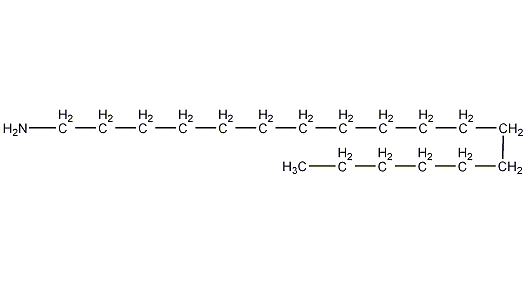
Structural formula
| Business number | 03J4 |
|---|---|
| Molecular formula | C18H39N |
| Molecular weight | 269.52 |
| label |
1-Aminooctadecane, Stearylamine, 1-Aminooctadecane, 1-octadecylamine, n-octadecylamine, Octadecaamine, Octadecylamine, stearylamine, Stearamine |
Numbering system
CAS number:124-30-1
MDL number:MFCD00008159
EINECS number:204-695-3
RTECS number:RG4150000
BRN number:636111
PubChem number:24858428
Physical property data
1. Properties: white waxy solid crystal
2. Freezing point: 53.1℃
3. Boiling point: 348.8℃, 199.5℃ (1.33kPa, 183.0-183.1℃ ( 0.665kPa)
4. Relative density: 0.8618 (20/4℃)
5. Refractive index: 1.4522
6. Flash point: 149℃
7. Solubility: easily soluble in chloroform, soluble in ethanol; ether; benzene, slightly soluble in acetone, insoluble in water
Toxicological data
Skin/eye irritation: Standard Dresser test
Rabbit skin contact, 20mg/24HREACTION SEVERITY, moderate reaction;
Rabbit eye contact, 20mg/24HREACTION SEVERITY, strong reaction Reaction;
Acute toxicity data: rat intraperitoneal LDLo: 100mg/kg; mouse intraperitoneal LD50: 315mg/kg
Ecological data
This substance may be harmful to the environment and special attention should be paid to water bodies.
Molecular structure data
1. Molar refractive index: 88.97
2. Molar volume (cm3/mol): 329.3
3. Isotonic specific volume (90.2K ): 777.3
4. Surface tension (dyne/cm): 31.0
5. Polarizability (10-24cm3): 235.27
Compute chemical data
1. Reference value for hydrophobic parameter calculation (XlogP): None
2. Number of hydrogen bond donors: 1
3. Number of hydrogen bond acceptors: 1
4. Number of rotatable chemical bonds: 16
5. Number of tautomers: none
6. Topological molecule polar surface area 26
7. Number of heavy atoms: 19
8. Surface charge: 0
9. Complexity: 145
10. Number of isotope atoms: 0
11. Determine the number of atomic stereocenters: 0
12. Uncertain number of atomic stereocenters: 0
13. Determine the number of chemical bond stereocenters: 0
14. Number of uncertain chemical bond stereocenters: 0
15. Number of covalent bond units: 1
Properties and stability
1. Basic properties: Sensitive to carbon dioxide. Alkaline.
2.This product is a high-grade alkylamine and is less toxic than low-grade alkylamines. According to the long-termNutrition studies show that feeding rats with 500*10-61 stearylamine in their food for two years had no obvious adverse health consequences, while feeding dogs with the same amount for twelve months had no pathological effects on gastrointestinal system mucus. . This product is irritating to skin and mucous membranes. Do not come into contact with skin. To prevent equipment leakage, operators must wear protective equipment.
Storage method
Storage: Cover and seal in a galvanized iron drum. During storage and transportation, the barrel mouth should be upward and away from fire and heat sources.
Synthesis method
1. Brief description of the production method: obtained by ammonification and hydrogenation of stearic acid. Stearic acid and ammonia are continuously and quantitatively sent into the liquid phase reaction tower, and ammoniated at 350°C to generate octadecanenitrile. After being washed and refined with water, it is added to the autoclave and hydrogenated under the action of a nickel catalyst at 130°C and a pressure of about 3.5MPa to generate octadecylamine. The hydrogenation product is precipitated to remove the catalyst to obtain the finished product. In the laboratory preparation, octadecanenitrile and absolute ethanol were boiled and refluxed, and metallic sodium was added to react. Pour the reaction mixture into dilute hydrochloric acid, cool it to obtain octadecylamine hydrochloride, and then treat it with 20% sodium hydroxide solution to obtain octadecylamine. The yield is 85%. Raw material consumption quota: stearic acid 1165kg/t, liquid ammonia 151kg/t, hydrogen 211m3, nickel catalyst 6kg/t.

2.Stearic acid and ammonia are continuously and quantitatively carried out ammoniation reaction in the reaction tower to obtain octadecylamine nitrile. After being washed and refined, it is put into an autoclave, and chlorine is added under the action of a nickel catalyst to generate octadecylamine.
Purpose
1. Used as an intermediate in organic synthesis to produce octadecyl quaternary ammonium salts and various additives, such as thickeners for cationic grease; mineral processing agents; pesticides and asphalt emulsifiers; fabric antistatic agents ; Softener; wetting agent and waterproofing agent; surfactant; bactericide; coupler for color film; boiler shutdown protection agent; corrosion inhibitor for oil refining equipment. By combining octadecylamine and ethylene oxide at a molar ratio of 1:2 and reacting at 150-190°C, octadecyldiethanolamine [10213-78-2] can be obtained with a yield of nearly 80%. Octadecyldiethanolamine is a non-ionic antistatic agent that can be used in polypropylene; polystyrene; ABS resin
2.octadecylamine Both iron and copper have good anti-corrosion effects. It can be used as a corrosion inhibitor in low-pressure boiler alkali feed water, condensate water system, other water systems and circulating cooling water. It is also an intermediate in organic synthesis.

 微信扫一扫打赏
微信扫一扫打赏

